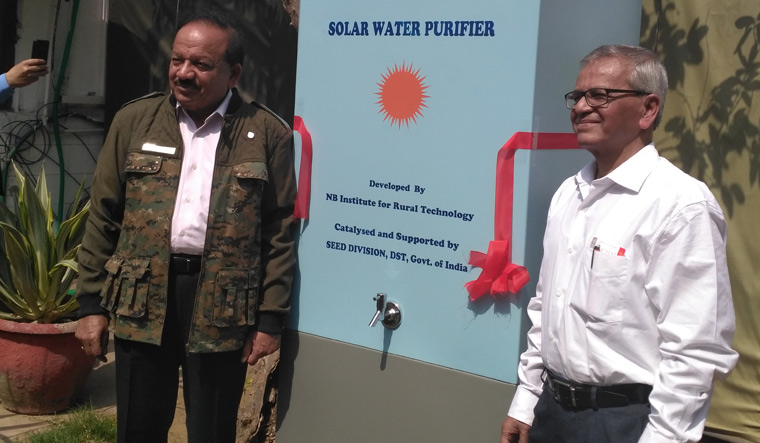Minister for Science and Technology Harsh Vardhan launched a solar-powered water purifier on Wednesday. Shortly after the launch in New Delhi, several schools across the northeastern states, where the purifiers had been installed in advance, started pouring out clean drinking water for students.
The water purifier, which is also enabled with a solar-powered pump to draw out water from the ground, was developed by the ministry's department of science and technology (DST). “The Oil and Natural Gas Commission has shown interest in this product. Water purifier manufacturing firms too have shown interest in solar technology. We are confident that this time, the laboratory to user gap will be breached,'' said S.P. Gonchaudhury of the Indian Institute of Science and Engineering, Kolkata, who is involved with the DST's solar powered devices projects.
The prototype of another solar-powered product was also on display. This is a jacket, the back of which has a series of miniature solar cells that charge while the wearer goes about doing outdoor work. They generate enough power to charge a mobile phone, shine an inbuilt torch and illuminate the name tally of the wearer. It even has the option of powering a pocket fan. It's designed for soldiers, trekkers and rangers.
Commercial models of DST-developed, solar energy-operated biometric ATMs should be out in the next three months. The minister said State Bank of India and Bandhan Bank had expressed interest in installing these devices in rural areas, where electric supply through the conventional route was erratic. The pilot product was launched some time ago in Kolkata. These ATMs are designed for people who are unlettered and find it difficult to use ATM cards with numerical PINs. The DST-developed ATM uses the person's biometrics, instead.
NITI Aayog has also asked the ministry to scale up production of the solar lanterns developed by it. Called the Surya Jyoti Bulb, these lanterns were distributed in a basti in Delhi first. Later, they were installed at several other areas in the country. NITI Aayog has asked the ministry to scale up the distribution to 10 lakh lanterns soon.
The minister said all these efforts were with the aim of increasing the component of solar power in the energy mix of the country. Prime Minister Narendra Modi set a target of generating 175 gigawatts of solar power by 2020, of which 20 per cent has been achieved. The minister's presentation came on the heels of the recently concluded International Solar Alliance Summit.
The minister said solar technology was being continuously improved, and the more people used solar-powered devices, the more there was scope for figuring areas of improvement.


